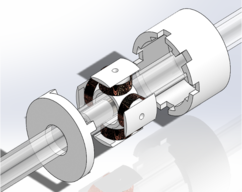Vitrector Device
TECHNOLOGY NUMBER: 2019-179

OVERVIEW
An inexpensive, hand-held, disposable device to sample vitreous humor- Use of a small gauge rotating needle with cutting action to collect sample
- An improvement over existing devices in diagnosing infections of the urea or globe
BACKGROUND
Vitrectomy is a type of eye surgery that involves removing the gel-like substance in the middle of the eye known as the vitreous, vitreous gel, or vitreous humour. Liquid biopsies are increasingly being utilized in diverse medical contexts as a minimally invasive approach to provide real-time information about a patient's disease status. By extracting and analyzing a sample of a given biological fluid, clinicians gain information about the tissue with which that fluid was in contact. Liquid vitreous biopsies are gaining attention as a potential diagnostic tool for a wide variety of conditions affecting the eye. The samples can be analyzed by a variety of different diagnostic tests to diagnose disease and guide treatment plans. These types of biopsies have historically been reserved for the most severe vision-threatening cases due to the risk of dangerous side effects like retinal detachment. As such, a need exists for improved technologies to evaluate vitreous gel safely and effectively.
INNOVATION
Researchers at the University of Michigan have invented the Vitrector, an inexpensive, hand-held, disposable device designed to remove a 250 μL sample of vitreous that can then be analyzed for diagnostic purposes. This device uses a small-gauge internal rotating needle with cutting action that is actuated through a magnet to extract a minimal fluid volume and requires no infusion component. These design features permit simplicity of use for the operator and provide a safer mechanism for liquid vitreous biopsy in the clinical setting. The main procedural mechanisms of the vitrector include a small-gauge (26 gauge) needle that cuts and "liquifies" tissue and facilitates extraction of a minimal volume of liquid for diagnostic analysis. The device facilitates an improvement upon existing devices and could prove to be a very useful diagnostic tool for infection of the uvea or globe. Additionally, the device could provide a liquid biopsy that leads to personalized medical treatments. This approach can also provide better access to the retina for surgical repairs, remove scar tissue, or replace cloudy or hardened vitreous.